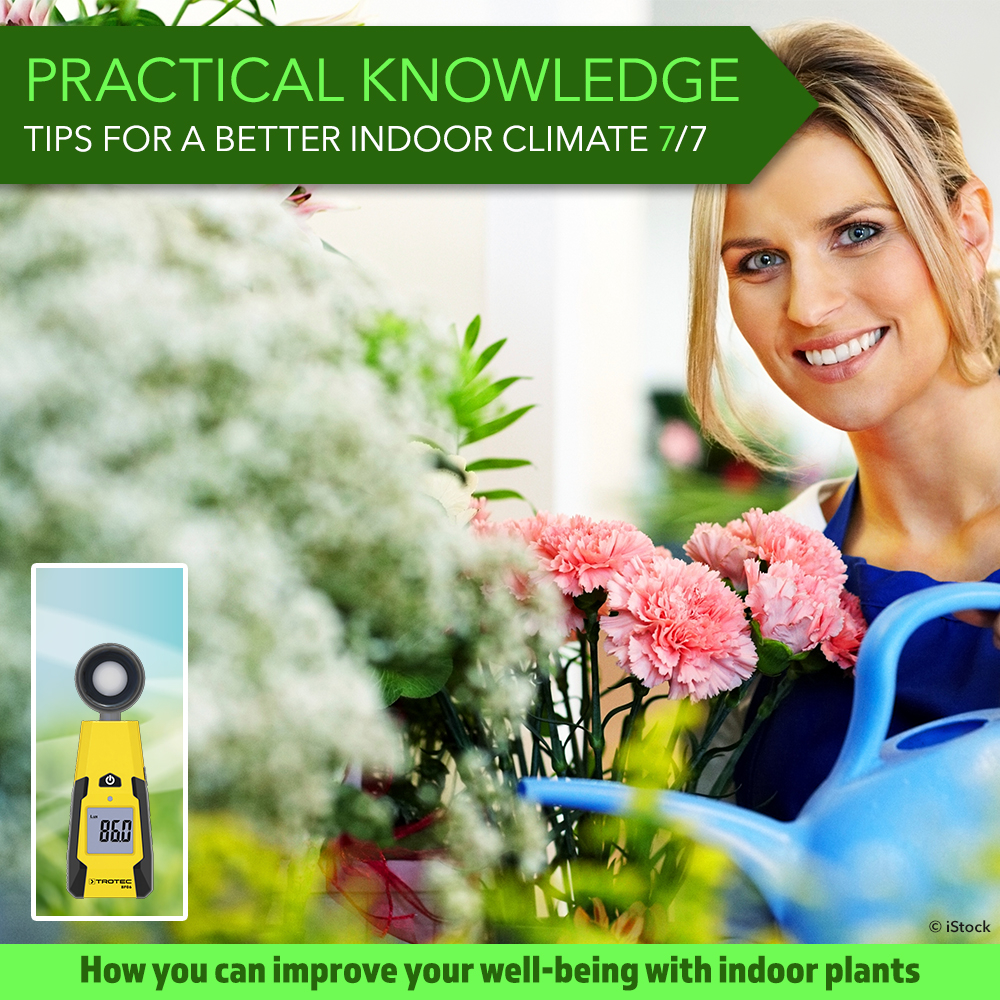 Sophisticated plants are every ambitious interior decorator’s insider tip as they make flats and houses look more ‘furnished’ and much cosier. And experts know that green indoor plants not only have a decorative effect, but also have a positive influence on the indoor climate. Because they not only provide oxygen and humidification, but are also natural air purifiers that can even bind pollutants. In return, they only require water and sufficient light, which you can easily check with the Luxmeter BF06 from Trotec. In the last part of our practical knowledge series, you will learn how we can benefit from the great properties of the plant world for a better indoor climate.
Sophisticated plants are every ambitious interior decorator’s insider tip as they make flats and houses look more ‘furnished’ and much cosier. And experts know that green indoor plants not only have a decorative effect, but also have a positive influence on the indoor climate. Because they not only provide oxygen and humidification, but are also natural air purifiers that can even bind pollutants. In return, they only require water and sufficient light, which you can easily check with the Luxmeter BF06 from Trotec. In the last part of our practical knowledge series, you will learn how we can benefit from the great properties of the plant world for a better indoor climate.
Let’s remind ourselves: photosynthesis is the name given to the biochemical process by which green plants convert carbon dioxide (CO2) into oxygen, among other things, which is valuable for us. This is done via chlorophyll from their leaves and with the help of sunlight. In addition, indoor plants do a lot for natural air humidification because they discharge more than 90% of the irrigation water, which is free of germs by the way, back into the environment. When temperatures are high in the summer, this supply of moisture keeps the air pleasantly cool. And all year round, house plants help us as prophylactic ‘cold blockers’. Because they enrich the air we breathe with moisture, the mucous membrane of the respiratory tract also remains moist – and is therefore much more resistant to pathogens. With dry heating air in winter, this is a boon for nasal mucous membranes and an effective prevention against colds.
The best pollutant controllers among indoor plants
From ‘air purifier’ to ‘cold blocker’, to ‘pollutant killer’: most of the qualities attributed to house plants refer to their positive effects on the indoor climate and on the air we breathe. Used correctly, indoor plants offer an ideal opportunity to improve indoor climate in a natural way. And many plants have other unexpected properties from which we can also benefit.
- Real aloe filters more formaldehyde out of the room air than any other plant.
- Peppermint is thought to promote cognitive performance and attentiveness with its fresh scent, according to a study by the University of New York. This is the ideal plant for an office or study.
- Ivy breaks down more benzene in the air than any other plant. Benzene is produced by cigarette smoke and can cause cancer.
- Peace lilies are also a very good controller for benzene and trichloroethylene.
- Lemon balm improves well-being with its fresh scent and according to a study by Ohio State University increases the production of the pain relieving hormone norepinephrine.
- Gardenia plants fill the entire room with their aroma and are therefore especially recommended as mood enhancers, especially in offices.
- Spider plants absorb enormous amounts of carbon dioxide and so permanently provide fresh air – ideal for rooms where a lot of people stay for a long time.
- Devil’s ivy breaks down carbon monoxide and benzene very well. It is also one of the plants that carries on actively breaking down particles even in low light levels.
- Dragon tree absorbs formaldehyde, trichloroethylene and also benzene very well. It is also well suited to dark places.
Luxmeter BF06 – ensures optimum light incidence for plants
All that we have to do for our plants in return is provide them with sufficient water and light – for one of those we have the tap, and for the other there is the BF06 Luxmeter from Trotec. With this light measuring device, you can measure the light penetration very simply, so that the plants also have the optimal light levels for improving the air.
Checking light incidence easily – thanks to innovative solutions from Trotec
Inform yourself comprehensively about all the advantages offered to you by our air quality management system. And take advantage of our current offer price: You can get the Luxmeter BF06 reduced from £44.20 to only £21.98, incl. VAT. – now in the Trotec Shop!
Trotec practical knowledge ‘Tips for a better room climate’
1/7 Simply ban viruses, allergens and fine dust from your home
2/7 How to ventilate your room correctly and sustainably
3/7 How to avoid dry indoor air and reduce the risk of corona infection
4/7 How to prevent excessive indoor humidity
5/7 How to prevent health-threatening mould growth
6/7 How to banish bad odours and stench from indoor air
7/7 How to improve your well-being with indoor plants

